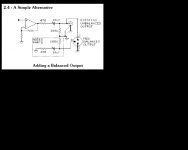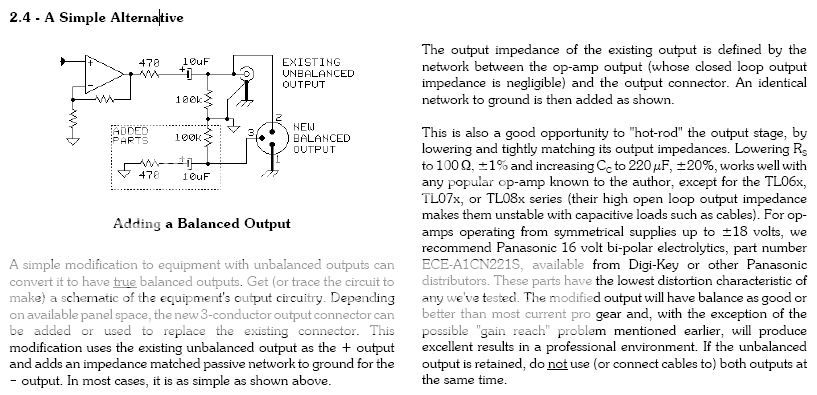How about the passive balanced input option Nelson often talks about ? 
Let's say, define the output Z of your pre. Easy, Use a sine in and a pot on the output.
Adjust pot until read voltage reaches 1/2 of the non loaded output. That is your output Z.
Then, use balanced input of the power amp; but terminate - in by a resistor of same value of Z out on the positive half ...
Any clues ???? That's named "passive balanced" I guess ...
Best,
nAr
Let's say, define the output Z of your pre. Easy, Use a sine in and a pot on the output.
Adjust pot until read voltage reaches 1/2 of the non loaded output. That is your output Z.
Then, use balanced input of the power amp; but terminate - in by a resistor of same value of Z out on the positive half ...
Any clues ???? That's named "passive balanced" I guess ...
Best,
nAr
I think "passive balanced" is the same as Jensen's pseudo balanced.
The output of the unbalanced source is converted to a balanced impedance output, but with signal only on the hot. The cold is connected to Signal Ground. Pin1 is connected to chassis.
The impedance looking back into the source is identical on both hot and cold. That is a requirement for a balanced connection.
Implement Jensen's modification and your unbalanced source becomes compatible with all balanced receivers.
The output of the unbalanced source is converted to a balanced impedance output, but with signal only on the hot. The cold is connected to Signal Ground. Pin1 is connected to chassis.
The impedance looking back into the source is identical on both hot and cold. That is a requirement for a balanced connection.
Implement Jensen's modification and your unbalanced source becomes compatible with all balanced receivers.
I think "passive balanced" is the same as Jensen's pseudo balanced.
The output of the unbalanced source is converted to a balanced impedance output, but with signal only on the hot. The cold is connected to Signal Ground. Pin1 is connected to chassis.
The impedance looking back into the source is identical on both hot and cold. That is a requirement for a balanced connection.
Implement Jensen's modification and your unbalanced source becomes compatible with all balanced receivers.
Thanks AndrewT
Best,
nAr
No, No, and No.
If you take an Aleph 2 and short pins 1 and 3, the gain of the amplifier
remains the same.
Passive Balanced? Who knows what they're talking about.
If you want the noise rejection of balanced with a single-ended source,
you do like I showed in the A75 article (how many years ago?).
Use balanced cable and terminate pin 3 through the appropriate value to
ground at the source.

If you take an Aleph 2 and short pins 1 and 3, the gain of the amplifier
remains the same.
Passive Balanced? Who knows what they're talking about.
If you want the noise rejection of balanced with a single-ended source,
you do like I showed in the A75 article (how many years ago?).
Use balanced cable and terminate pin 3 through the appropriate value to
ground at the source.
That sounds like a description of Jensen's Pseudo Balanced output schematic.,,,,,,,Use balanced cable and terminate pin 3 through the appropriate value to
ground at the source.
Jensen's term pseudo balanced is referring to a unbalanced-balanced connection where symmetrical cable is used and pin 3 and shield are connected at the source, inside RCA-connector for example. Impedance balanced On the otherhand is a method discribed by Mr. Pass where you connect pin3 to GND at the source with a resistor equal to output impedance.
Jensen's schematic shows the Source modification.
The Pseudo part is inside the Source.
That modification converts the unbalanced Source into a balanced Source.
That balanced source is now compatible with all balanced receivers via a balanced connection cable.
CF,
have another look at the attachment
You will see that Cold is connected to Signal Ground. It's as Pass described above.
The Pseudo part is inside the Source.
That modification converts the unbalanced Source into a balanced Source.
That balanced source is now compatible with all balanced receivers via a balanced connection cable.
CF,
have another look at the attachment
You will see that Cold is connected to Signal Ground. It's as Pass described above.
Attachments
Andrew, that must be from Jensen AN-003 document? Pseudo balanced is introduced earlier in that document and is not to be confused with impedance balanced (your picture).
Anyway, impedance balanced is much better than pseudo balanced and pseudo balanced is better than unbalanced.
Anyway, impedance balanced is much better than pseudo balanced and pseudo balanced is better than unbalanced.
The pic in post 12 is the Pseudo balanced modification that Jensen show to convert an unbalanced output (source) to balanced impedance output.
This appears to be what Pass refers to and describes in post8
What do you mean
This appears to be what Pass refers to and describes in post8
What do you mean
when they appear at least to me to all be the same thing?Pseudo balanced is introduced earlier in that document and is not to be confused with impedance balanced (your picture).
Anyway, impedance balanced is much better than pseudo balanced
No, No, and No.
If you take an Aleph 2 and short pins 1 and 3, the gain of the amplifier
remains the same.
Yes
Passive Balanced? Who knows what they're talking about.
If you want the noise rejection of balanced with a single-ended source,
you do like I showed in the A75 article (how many years ago?).
I'll read about it. Sorry I'm a little young for A75 story, I started the story at Alephs
Use balanced cable and terminate pin 3 through the appropriate value to
ground at the source.

Thanks for the clarification Mr PASS
My question would reside, if I terminate pin 3 through the appropriate value to ground at the source, will I same gain figure as if it was directly shorted to ground ?
I mean, if the gain of the amp stays the same, and we feed an unbal pseudo balanced impedance signal like said above, the noise character will be the one of a balanced source,
but as input signal amplitude is divided in 2 compared to same (but balanced) signal, does the speaker at the output see half the voltage only ?
Like
2,8V balanced
gain 20dB (x10)
speaker sees 28V
1,4V unbalanced, amp input pin 3 shorted to ground
gain 20 dB (x10)
speakers sees 14V
1,4V unbalanced, pin 3 to Gnd via matching source impedance at preamp output (let's say 100 ohms if preamp output Z is 100 ohms)
gain ? still 20 dB, or less ?
speakers see ???
This wasn't totally clear to me
Sorry for the trouble ... Sponge Bob, you can kill the thread if you wish

Best,
nAr
CFM refers to the approach attached below; taken from the same application note (003).

then CFM is wrong.
That "cable" has nothing to do with pseudo balanced and certainly does not fit with the Pass description.
But maybe you need to let CFM speak rather than you guessing what he is/was thinking.
Edit.
I have found the pseudo reference in fig2.1
CFM is correct. The cable is the pseudo balanced.
Unfortunately, I have been referring to the fig under heading 2.4 as pseudo for years. My mistake.
Last edited:
I have that screenshot I attached, permanently on my desktop, so that I can use it if necessary. It is clearly labeled Jensen Pseudo Balanced.png I must have been having a bad day that many years ago.
I am going to offer a pathetic excuse:
just maybe some other document refers to the fig2.4 modification as psuedo balanced.
BTW,
that fig2.1 is the basis of one of the examples I offered in the NFB tapping points Thread.
I am going to offer a pathetic excuse:
just maybe some other document refers to the fig2.4 modification as psuedo balanced.
BTW,
that fig2.1 is the basis of one of the examples I offered in the NFB tapping points Thread.
Last edited:
- Status
- This old topic is closed. If you want to reopen this topic, contact a moderator using the "Report Post" button.
- Home
- Amplifiers
- Pass Labs
- how change the balance input to unbalance input in PASS amp?

